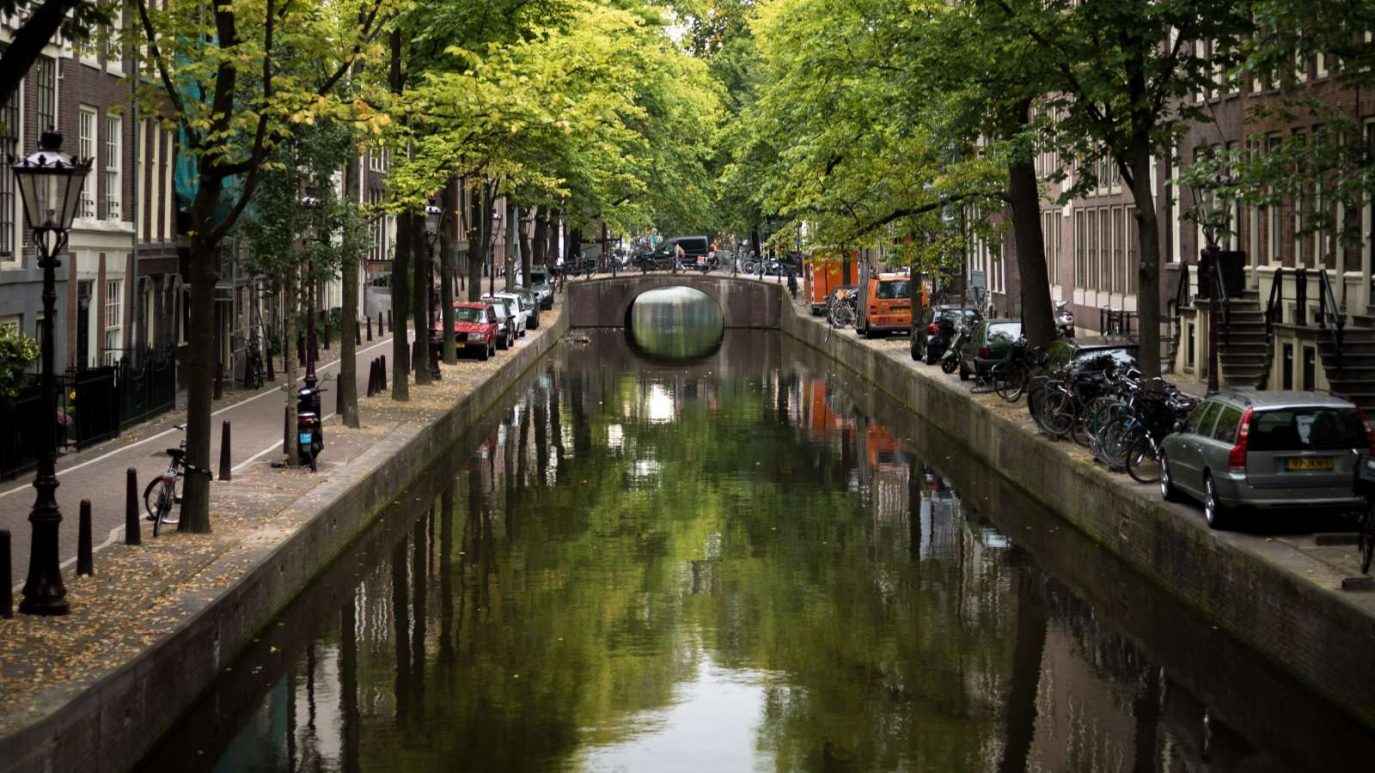What To Expect
Besides the Schonbrunn Palace and the Vienna Hofburg, the Innsbruck Hofburg is one of the most prominent buildings of Austria (aesthetically as well as historically). 28 rooms shine like precious jewels in the 2,000 sq. meters of this palace. Much of what you see today in the Innsbruck Hofburg including the marvellous rococo façade, chapel and stateroom is the work of Maria Theresa (lovingly called the mother of Austria).
Her importance (only female empress of Habsburg dynasty) can be gauged by the fact that the medieval core of Innsbruck (Altstadt) is cut by a very busy main road that’s named after the empress ‘Maria Theresien Strasse’. A natural activity following the Hofburg visit will be a stroll along this famous road that seems to rest against the Nordkette range.
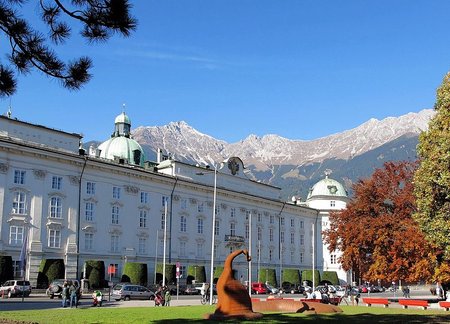
Another empress Elisabeth (popularly known as Sisi) claims a major chunk of the Hofburg that’s open to visitors. Empress Sisi (wife of Emperor Franz Joseph) was not politically astute but she was famed for her beauty, her love for nature and literature and her support for democracy. The Sisi museum faithfully reproduced in her favoured 19th-century style, features rooms and furniture that were used by the queen on her visits to Innsbruck. …this is arguably the most expensively furnished space of the Hofburg.
To visit the Hofburg is to be inextricably drawn into the stories of the royals and most tourists prefer taking a guided tour of the palace and sensitize themselves to the history of the palace and Habsburg dynasty, otherwise, most of the displays will seem beautiful but meaningless objects of art.
History
It’s strange to think that the grand Hofburg was originally just a complex of medieval houses in the historical heart of Innsbruck (now known as Old town). This place was chosen to become a royal castle because of its strategic position… it stood on a busy road leading to the Brenner pass (an important Alpine pass) and was considered to be a coveted area in the Tyrol region. The House of Habsburg started ruling Tyrol in 1363 and almost always remained in power till 1918 which is why most imperial buildings of the Tyrol region are connected with this dynasty.
It was back in 1465 that Archduke Sigmund Rich noted with deep joy that he had just completed a wonderful architectural project… Imperial Palace in Innsbruck (locals soon started calling it Hofburg). The Hofburg was at its inception a Gothic-style castle with huge representation rooms, a chapel and a heated banquet hall (a rarity in those times), twirling staircase, wall furnishings and living room with huge windows. 3 major constructional elements of the medieval city fortification project were incorporated… the city walls, city towers, armoury and a multitude of subject houses (these still exist today).
However, the archduke was unaware of the fact that this beautiful palace will become the favourite residence of the Habsburgs… though in effect the Habsburgs had begun ruling Tyrol since 1361. In the 15th century, emperor Maximilian expanded the Hofburg further in the late Gothic period and the northern part of the building complex was used as the house of Bianca Maria Sforza. Incidentally, Nikolaus Thuring (Elder) was deeply involved in planning the castle and he is the same builder who created the gorgeous Goldenes Dachl.
By 1530 Hofburg had become a walled-in complex with a succession of courtyards and different wings and by 1533 Ferdinand I had permanently shifted here. An Italian architect Lucius Spaciis began creating a Renaissance look to the till then Gothic Hofburg. Ferdinand II continued the renaissance overall with yet another master Italian builder Giovanni and this was when expensive murals and highly decorative furniture began dotting the palace. Soon after the 30 years’ war began and the Hofburg fell into disrepair and was no longer used as a permanent residence… it only gained its present beauty and magnificence after the advent of Empress Maria Theresa (1717 to 1780).
Maria Theresa was a politically prominent and astute queen who thought correctly that an alliance of her second son (Leopold) with the Spanish princess Maria Ludovica would prove to be advantageous. The Hofburg underwent many renovations and most of its existing furniture were removed for the wedding that was held in 1756 but was also marked by a tragedy as Maria Teresa’s husband (Emperor Francis I Stephan) unexpectedly died in Innsbruck. Again a series of renovations happened across the chapel, stateroom-Giant’s hall and Triumphal arch. In 1766 Maria Theresa’s royal builder ‘Nikolaus Pacassi’ helped local builder Constantine Walter in finishing work on the castle and the Noble Women’s Collegiate Foundation.
In 1776 the royal family’s version of the Hofburg in the present Rococo style was completed. The Habsburgs gave away Tyrol to Bavarian armies in 1805 and Maximilian I Joseph made it his residence. In 1809 Andreas Hofer (the valiant freedom fighter who led the Austrian army in the 3rd battle of Bergisel) made the Hofburg his residence briefly.
Later Tyrol was returned to Austria and the last renovation work on the palace happened when the residential area was decorated in 2nd Rococo style. This was also when the Elisabeth rooms were created and these were inspired by Castle Schonburg. Much of what you see today in the Imperial apartments especially in the Sisi section was created at this point and no expense was spared to create an atmosphere of elegance and richness as befitting Elisabeth who was known for her beauty and taste. The castle was converted into museum showrooms and their revitalisation continued till 2010.
What to See & Do
Notice that today’s Hofburg has 5 main themes which include some of Maria Theresa’s rooms with 18th-century design and Elisabeth’s rooms with 19th-century design. There is also a furniture museum that depicts the changing styles of furniture during each reign, a painting gallery and the rather ostentatious Ancestral gallery in the reception area. The demarcation of themes enables visitors to move across clear structures in an organised way. The palace is vast but only a few spaces including Chapel, Imperial apartments and the Giants Hall are open to visitors.
Structure
The façade is beautiful and has Baroque-Rococo style with white marble and blue accents. The palace appears like a magnificent vision when you approach it from the main gate and you will probably linger for a long time admiring it and taking countless pictures. The façade is popularly known as the Pacassi façade (made by Maria Theresa’s court architect Nicolo Pacassi).
Note that a big courtyard stands at the middle of Hofburg and the Hofgasse wing flanks it on the south while the long curved Rennweg wing with two round towers flank it to the North. The east wing is a little further off but it contains the most remarkable displays i.e. the Guards Hall, Riesensaal/ Giants Hall, Imperial Apartments and Lothringer Zimmer/ Lorraine Room. The Rennweg façade is the oldest… its curved structure points towards the city’s old wall and moat.
Vestry
The sacristy cupboard and a number of liturgical items are the main highlights of the vestry. Note the prominent Baroque fresco on the ceiling.
Hofburg Chapel
The chapel entrance has a vestibule that contains mementoes of the marriage of Leopold and Maria Ludovica in August 1765. This was originally a lobby but was later converted into a chapel after the death of Maria Theresa’s husband Francis I. The king died in this room and this is still used as a prayer place by the Collegiate of Noblewomen. Dark wood praying seats and an elegant altar with marble statues and a simple Gilt cross creates a sombre yet ethereal atmosphere. The chapel’s structure is held by Pilasters which feature rocaille stucco decorations.
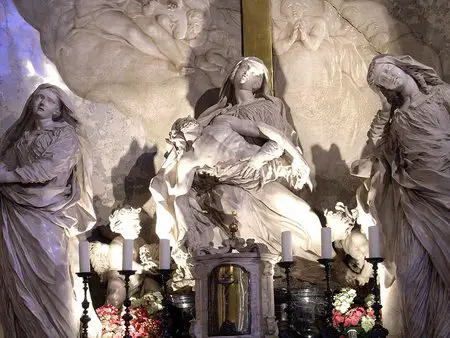
Note the crowning scroll at the apex of the altar… it has Maria Theresa’s initials MT and a painted relief showing God surrounding by mourning angels. The sculptures show the lifeless body of Jesus held in the arms of the Virgin Mary while others mourn. This is a poignant space and an adjoining room contains death crowns used by the royal family.
Court Table
This is a huge ornately decked up table with overhead chandeliers and upholstered chairs. Note that in the days of kings a typical dinner had between 9 to 13 courses. The emperor used to sit at the head of the table and he was flanked by an alternation of men and women. The tale is set up with fine cutlery, crystal-ware and beautiful candelabras… you can admire but you aren’t allowed to touch any of it.
Giants Hall/ Riesensaal
Most tourists say that the Giant’s Hall is the most breathtaking of all spaces in the castle. This was designed according to the Grand Gallery in Schonbrunn Palace and it extends across the entire width of the east wing while containing two floors and seven window axes.
The hall has portraits of all of Maria Theresa’s children and grandchildren. She had 16 children and more than 40 grandchildren. Incidentally, the infamous Marie Antoinette was her daughter too. You will notice that the paintings of her children are ranked according to their birth. 3 of the empresses children died young and they are shown floating like cherubs in a single painting.
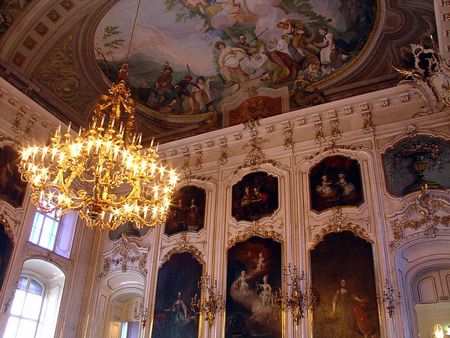
Right next to the emperor’s portrait there is the portrait of Joseph II (heir to the throne). There are pictures of the other members of Habsburg and Lorraine (Maria Theresa’s clan). The Giants hall got its name because of a cycle of Hercules frescoes that used to decorate it. There are large mirrors that line the walls so you can see all the portraits clearly.
The ceiling is covered in artistic chandeliers and it’s easy to envision how this space was once used for majestic royal parties. The beautiful Ceiling frescoes (500 sq. meter) by Franz Anton Maulbertsch date back to 1770 and represent the theme “Unification of the Habsburg & Lorraine dynasties” and “Regalia of Tyrol”. The Giants hall is still used as a banquet and events hall.
State Rooms
Two Staterooms remain adjacent to the Giants Hall and they are the Audience Chamber and the Guard Room. The Audience Chamber is a tribute to the house of Lorraine (Joseph I’s dynasty). There are portraits of the emperor’s parents, grandparents and Maria Theresa and Francis Stephen. The Guard Room was originally designed as a reception room and it pays homage to the political triumphs of the Lorraine dynasty. Some of the more prominent paintings here show wars against the Ottoman Empire.
Council Chamber
This too is filled with paintings and they reflect Habsburg’s strong alliance with the Catholic Church. Of particular interest is a painting that shows a Habsburg organisation… the order of the Golden Fleece… a prestigious Christian order. Emperor Francis Stephen sits with both his sons Leopold and Joseph in the painting and all of them are wearing chains that are decorated with golden fleece.
Imperial Apartments
After the Giant’s Hall, the Imperial Apartments are probably the next in the order of stateliness and interest. The Imperial Apartments are in the ‘women’s side’ of the Hofburg and quite obviously showcase a range of activities targeted towards the royal women and their husbands (whenever they could find time from the court). There are dressing rooms, extensive beauty salons with a staggering range of racks and shelves, many bedrooms… all featuring different colours.
There are two distinct sets of rooms here both belonging to different empresses of different tastes (Maria Theresa and Elisabeth). Maria Theresa’s rooms have a baroque 18th-century style while Empress Elisabeth’s rooms have the late 19th-century 2nd Rococo style with pure silk furnishings, gilded utensils, fitted carpets and rare tapestries. Note that though the rooms are labelled as Empress Elisabeth, she only visited the palace twice… it was used more by her husband emperor Franz Joseph.
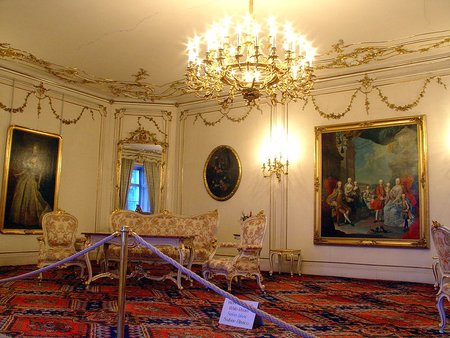
The Hofburg inner apartments were redecked on the instruction of Archduke Karl Ludwig for his sister in law Elisabeth and they comprised a salon, dressing room, study and bedroom. It’s interesting to note how different rooms have different colour themes, for example, the bedroom is furnished in green silk damask and the salon (biggest room) is furnished in red damask and has 22 chairs with a large precious wood table. Note that there is a spittoon in each room… a clear indication of how the royalty used to chew tobacco in those days.
The Imperial Apartments also have a dining room and that’s set for dessert with exquisite tableware. The centrepiece in the middle of the tale is made of gilded bronze and has mirrors, candle holder rings, statuettes and grandoles… one of the most valuable objects in the Hofburg (was created for the coronation of Ferdinand I). One of the brightest and most beautiful rooms in Elisabeth’s apartments (and used mostly by her husband) is the study that’s done up in azure blue with lovely white, gold and blue furniture and precious items made by the craftsmen of Tyrol. The other bedrooms and salons in the Imperial apartments are not as grand as Elisabeth’s apartments.
Furniture Display Room
There is a staggering range of furniture in here right from the elaborate courtly furniture to the more elegant Biedermeier style. Rare chairs from Maria Theresa’s reign are also put up on display along with original chairs created by Court Joiner Johann Geyr and precious bentwood furniture made by the Thonet brothers. There is also a range of servant’s chairs… simple and stark and used by the hundreds of servants that the royal family employed.
Other Features
Each room has information displays in English that is helpful for understanding the history and important facts about that specific room. There are frequent rotating exhibitions held at the Hofburg and they provide rich insight into the lives of the royals.
Each year in July, Innsbruck Promenade Concerts are held in the lovely open-air venue of the Hofburg inner courtyard. This is known to be one of Europe’s best brass festivals and summer night concerts comprising of marches, jaunty numbers and waltzes etc. happen here. All performances are free of charge though donations are welcome. The festival usually lasts for 28 days and ensembles, brass groups and orchestras from all over Europe congregate to deliver free performances.
Open Hours, Tours & Tickets
The museum is open from January to December (9 am to 5 pm). It remains closed on certain holidays.
One entry ticket for an adult costs 9.50 euros and anyone under the age of 19 gets free entry.
Every Sunday at 2 P.M. a guided tour is held at the Hofburg by the museum authorities… the tour is targeted especially at families… the tour lasts for 45 minutes long. Tour fee for adults is 3.50 euros while the fee for children is 2.50 euros. Also, Sundays are family days at the Hofburg… families bringing their kids to get free entry inside.
Or else you could take a combined city tour by Viator that will expose you to the various attractions of the old town like Hofkirche, Golden Roof along with Hofburg.
Ticket prices include the cost of an audio guide and that’s available in English, French, Spanish and German. The audio guide is interesting and also speaks about the restoration project in detail so you will be able to envision the Hofburg at different points of time… you need to submit some sort of ID and explicitly ask for the audio guide though!!
Note that some exhibits in a few rooms also show displays that tell tourists about the restoration project. No photography is allowed in most of the rooms and that’s bad news for all photography lovers. There are room Chaperones in every room who keep an eye on visitors. Staff are very helpful otherwise and they will gladly talk about the history of the palace and regale visitors with stories.
Entry is free for holders of the Innsbruck Card.
Location & Contacts
The Imperial Hofburg is in Innsbruck Old Town and it’s in a particularly accessible location. You can reach Hofburg by a 15-minute walk from the railway station and from the airport by a 20-minute ride. The Bus Line F will take visitors to the Congress stop and from there it’s a few minutes walk to the Hofburg. The Tram will stop at the Museumstrasse stop and the City Sightseer bus will stop in front of the Hofburg. There are many major parking garages within a one km radius of Hofburg so it’s convenient to arrive even if you are bringing your own vehicle.
Burghauptmannschaft Österreich
Wien – Innsbruck, 6020 Innsbruck | Rennweg 1
Phone: +43 – (0)1 536 49 – 814111; +43 (0)512 – 587 186 – 19; Website
After you visit the Hofburg you would come back impressed by the wealth, political clout and aesthetic sensibilities of the Habsburgs. Naturally, you may feel like visiting the city’s most beautiful and culturally rich landmark that’s tied deeply to the House of Habsburgs. The Arch of Triumph is a royal arch that was erected at the position of the erstwhile south Gate of the castle as a result of the orders issued by Maria Theresa in 1976. The Empress wanted the Triumphal Arch to celebrate the marriage of her son Leopold II with Princess Maria.
The arch was made from pure stone and it’s almost unscathed till today. There are reliefs all around the Arch of Triumph that depicts Maria Theresa and the Habsburg Monarchy. You will find this arch at the south end of the Maria Theresien Strasse… a beautiful walking site that shows off the beauty of the Nordkette. The southern side of the arch has motifs that describe the wedding of the royal couple and its northern side pays homage to the death of the emperor. You will be able to recognise some of the motifs from afar like the Austrian archducal hat, Bohemian Wenceslas crown, Maria Theresa and Francis Stephen wearing Laurel wreaths and the newly wedded Archduke Leopold and Maria Luisa etc.
You can also visit the Hofkirche but some might find so much grandeur overwhelming in a single day. The Dom zu St Jakob and the Golden Roof House are also nearby. Simply walking through the Altstadt (old town) will be a nice experience… the Habsburgs have left their mark at many places.
If you want to grab a bite then there is Fischerhaus a few steps away on Herrengasse… it’s known for comfort food and Austrian cuisine. Then there is Speckeria on Hofgasse that serves good German food and Strudel Café Kroen (cash only) that serves great coffee and desserts.
 A travel addict. Still celebrating the day when he quit his high-profile corporate job to pursue his passion for travel writing.
A travel addict. Still celebrating the day when he quit his high-profile corporate job to pursue his passion for travel writing. 